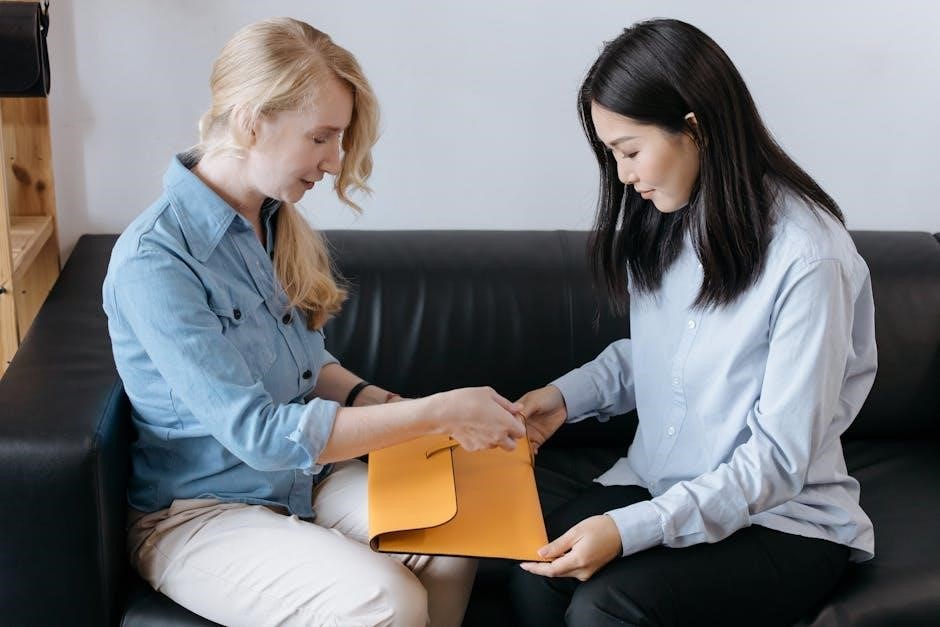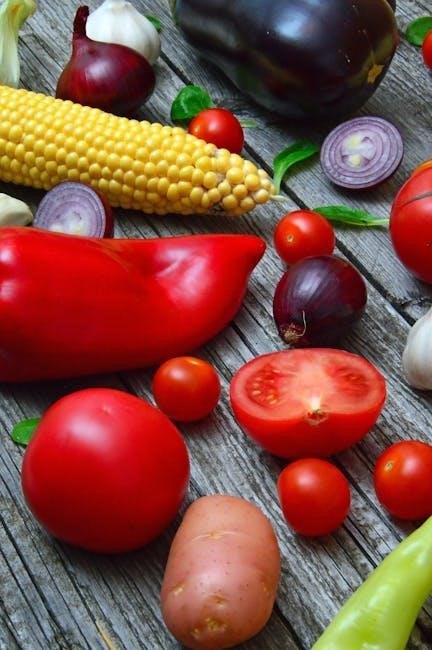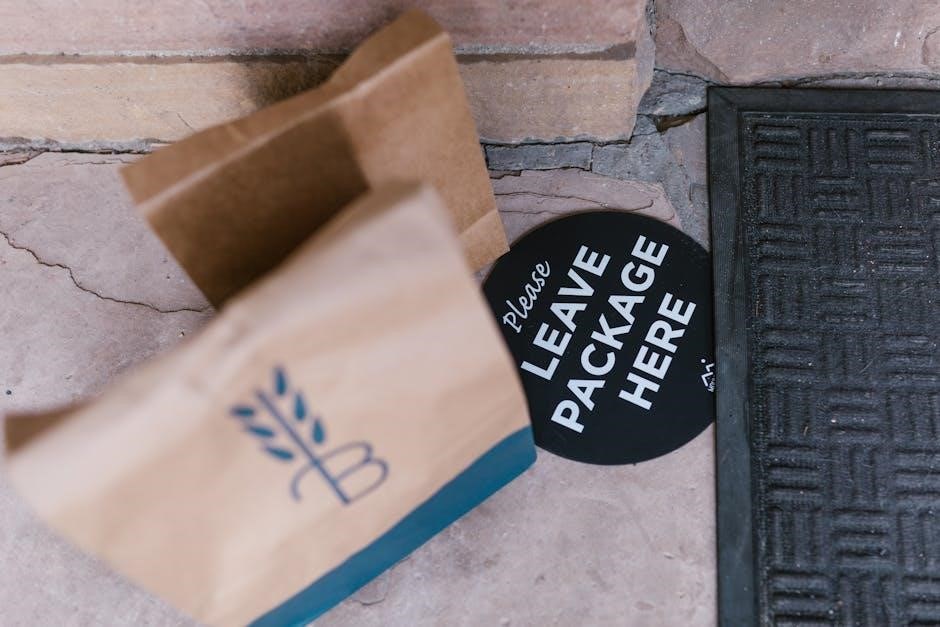A handy tool for microwave cooking, the potato bag allows quick, mess-free preparation of potatoes and vegetables. Its design ensures even cooking and retains moisture for fluffy results. Reusable and easy to clean, it’s a practical kitchen accessory for home cooks. Perfect for busy households, this bag simplifies meal prep while maintaining flavor. Discover how to use and care for it effectively with these comprehensive guides.
What is a Potato Bag?
A potato bag is a reusable, microwave-safe pouch designed for cooking potatoes, sweet potatoes, and other vegetables quickly and evenly. Typically made from 100% cotton fabric, it retains moisture while allowing steam to escape, ensuring fluffy interiors and tender skins. The bag is simple to use: place clean, dry potatoes inside, seal the opening, and microwave. It’s ideal for 1-4 potatoes, with cooking times varying from 3-15 minutes depending on size and quantity. The bag is also versatile for cooking corn on the cob, tortillas, and other vegetables. Machine washable and durable, it’s a practical kitchen tool for home cooks seeking convenient, mess-free meal preparation.
Benefits of Using a Potato Bag
A potato bag offers numerous benefits for home cooks, providing a convenient and efficient way to prepare potatoes and vegetables. It ensures even cooking and retains moisture, resulting in fluffy interiors and tender skins; The bag is reusable, making it an eco-friendly alternative to disposable options. Its microwave-safe design allows for quick cooking, saving time compared to traditional oven methods. The bag also prevents messes and cleans up easily, while its compact size is ideal for small kitchens. Additionally, it can be used for a variety of vegetables and even heating tortillas, making it a versatile tool for meal preparation. Overall, it enhances cooking efficiency while maintaining flavor and texture.

Materials Needed for a Potato Bag
To create a potato bag, you’ll need 100% cotton fabric, coordinating thread, batting for insulation, measuring tools, scissors, and basic sewing supplies like a sewing machine and pins.
Fabric Selection
Choosing the right fabric is crucial for your potato bag. Opt for 100% cotton, as it is safe for microwave use and breathable, ensuring even cooking. Avoid synthetic fabrics like polyester, as they can melt or catch fire. Select a durable, tight-weave cotton to retain heat and moisture. Pre-wash the fabric to remove any finishes and shrink it before sewing. Consider a fun, food-themed pattern for a decorative touch. Ensure the fabric is large enough to accommodate the potatoes comfortably, typically around 18×24 inches. Natural fibers are essential for safety and performance, so stick to cotton for best results. This ensures your bag is both functional and aesthetically pleasing.
Thread and Batting
Selecting the right thread and batting is essential for your potato bag; Use 100% cotton thread to ensure safety in the microwave, as synthetic threads can melt or ignite. For batting, choose a thin, microwave-safe cotton or bamboo option to retain heat and moisture. Avoid polyester batting, as it may not perform well under high temperatures. Pre-wash both the fabric and batting to remove any chemicals or shrinkage. When sewing, use a consistent stitch length to ensure durability. The thread should match the fabric color for a seamless look. Proper thread and batting selection will ensure your bag performs optimally and remains safe for microwave use. This step is vital for both functionality and longevity.
Measuring Tools
Accurate measurements are crucial when creating or using a potato bag. A ruler or measuring tape is essential for cutting fabric to the correct dimensions. Use a ruler to ensure straight, precise cuts, especially when working with patterns or templates. A measuring tape can help measure the circumference or length of fabric needed for the bag. Additionally, consider using a sewing gauge for smaller, detailed measurements. Sharp scissors or rotary cutters are also necessary for clean, accurate cuts. Proper measuring tools ensure your potato bag is the right size for cooking potatoes evenly. Always double-check measurements to avoid errors. This step ensures your bag functions optimally and cooks potatoes consistently.
Sewing Supplies
To sew a potato bag, you’ll need a few essential supplies. A sewing machine is recommended for efficiency, but hand-sewing with a needle and thread can also work. Use sharp scissors or a rotary cutter for clean fabric cuts. A sewing gauge or seam guide helps maintain consistent seam allowances. Pins are necessary to secure fabric layers together. Thread should match the fabric color, and cotton or polyester blends are ideal. Optional supplies include a seam ripper for corrections and an iron for pressing seams. Gathering these tools ensures your potato bag is well-constructed and durable. Proper sewing supplies are key to creating a functional and long-lasting bag for microwave cooking.

Step-by-Step Instructions for Using a Potato Bag
Place 1-4 clean, dry potatoes in the bag, seal with the flap, and microwave for 3-4 minutes per side. Reusable and great for vegetables too.
Preparing the Potatoes
Start by washing the potatoes thoroughly under clean water to remove any dirt or debris. Scrub the skins gently with a vegetable brush for a cleaner finish. Pat the potatoes dry with a paper towel to eliminate excess moisture, ensuring even cooking. For larger potatoes, pierce the skin with a fork a few times to allow steam to escape and prevent bursting. Leave the skins on for texture and nutrients. If desired, you can season the potatoes with salt, herbs, or spices before placing them in the bag. This step ensures your potatoes are ready for optimal cooking results in the microwave.
Placing Potatoes in the Bag
To ensure optimal cooking, place 1-4 medium-sized potatoes directly into the bag, depending on its size and your microwave’s wattage. Position them in a single layer for even cooking. For smaller quantities, dampen the bottom of the bag lightly with water to enhance moisture retention. Avoid overcrowding, as this can lead to uneven cooking. If using for other vegetables or corn on the cob, wrap them in a damp paper towel before placing them in the bag. Ensure the opening of the bag is facing downward when microwaving to trap steam effectively. This step ensures your potatoes or vegetables are properly positioned for the best results.
Sealing the Bag
Properly sealing the potato bag is essential for trapping steam, which ensures even cooking. Most bags feature a simple fold-over flap; follow the manufacturer’s instructions for securing it. Place the bag in the microwave with the opening facing downward to prevent steam from escaping. Avoid tying the bag too tightly, as some steam release is necessary to prevent pressure buildup. If your bag has Velcro or another closure, ensure it is securely fastened. For bags without a built-in closure, folding the top over 2-3 times and pressing gently will suffice. Proper sealing ensures your potatoes cook evenly and retain moisture for fluffy results. Always check the bag’s orientation before microwaving to avoid any issues during cooking.
Microwave Cooking Times
Microwave cooking times vary depending on the number and size of potatoes. For 1-4 medium potatoes, cook for 8-15 minutes, adjusting based on your microwave’s wattage. Smaller potatoes require less time, while larger ones may need up to 20 minutes. Always follow the bag’s instructions for optimal results. If cooking fewer potatoes, dampen the bottom of the bag to ensure even steam distribution. Cooking in 3-4 minute increments allows you to check for doneness without overcooking. Use a fork to test if potatoes are tender. Adjust timing for sweet potatoes or other vegetables, ensuring they reach desired softness. Consistent cooking times guarantee perfectly cooked potatoes every time. Always prioritize safety and even cooking for the best results.
Checking for Doneness
To ensure your potatoes are perfectly cooked, check for doneness by gently inserting a fork through the fabric into the potato. If it slides in easily, the potato is cooked. For optimal results, avoid overcooking, as this can make the potatoes dry. After microwaving, carefully remove the bag using oven mitts and let it stand for a minute to allow residual heat to finish cooking. Always be cautious of hot steam when opening the bag. This method ensures your potatoes are tender and fluffy every time, while preventing them from becoming overcooked or mushy. Proper checking guarantees the best texture and flavor for your meal.

How to Care for Your Potato Bag
To maintain your potato bag, wash it in cold water with mild detergent. Air dry thoroughly to prevent shrinkage. Store in a dry place to preserve quality.
Washing Instructions
For optimal care, wash your potato bag in cold water using a mild detergent. Hand washing is recommended to prevent fabric wear, but machine washing on a gentle cycle is also acceptable. Avoid using bleach or harsh chemicals, as they may damage the material. Gently scrub any food residue with a soft sponge before rinsing thoroughly. Do not soak the bag for extended periods, as this could weaken the fabric. Allow the bag to air dry completely, ensuring no moisture remains to prevent mildew. Regular cleaning ensures the bag remains hygienic and maintains its cooking efficiency. Proper washing helps extend the lifespan of your potato bag.
Drying the Bag
To properly dry your potato bag, lay it flat on a clean, dry surface or hang it in a well-ventilated area. Avoid exposing it to direct sunlight, as this may cause fading or fabric weakening. Do not place the bag in a dryer, as heat can damage the material or cause shrinkage. Air drying is the safest method to maintain the bag’s integrity. Ensure the bag is completely dry before storing it to prevent mildew or unpleasant odors. If using a towel to blot excess moisture, gently pat the fabric without rubbing. Proper drying ensures the bag remains in good condition for future use. Regularly drying the bag after washing helps maintain hygiene and longevity.
Storage Tips
Store your potato bag in a cool, dry place away from direct sunlight to prevent fading or fabric degradation. Lay it flat or hang it to maintain its shape and prevent creases. Avoid folding or bunching the bag, as this may cause permanent wrinkles. Keep it separate from metal objects to prevent static cling. For optimal freshness, ensure the bag is completely dry before storage. Do not store it near strong-smelling items, as the fabric may absorb odors. Proper storage will help maintain the bag’s quality and ensure it remains effective for future use. By following these tips, you can extend the lifespan of your potato bag and keep it looking like new.

DIY Potato Bag: How to Make Your Own
Create a microwave potato bag quickly without a pattern. Using 100% cotton fabric, thread, and basic sewing tools, it cooks up to four potatoes perfectly.
Measuring and Cutting Fabric
Start by selecting 100% cotton fabric, as it’s safe for microwave use and allows steam to escape. Measure and cut two fabric pieces, each approximately 9×12 inches. This size is ideal for holding 1-4 potatoes. Use a ruler or cutting mat for accuracy. Ensure the fabric is smooth and wrinkle-free before cutting. Cut neatly along the marked lines to maintain even edges. If desired, add a 1-2 inch flap for the bag’s closure. Set the cut fabric pieces aside for sewing. Proper measurement is key to ensure the bag fits your needs and cooks evenly. This step sets the foundation for a functional and durable potato bag.
Sewing the Bag
Place the two fabric pieces right sides together and pin along the edges. Sew around the perimeter using a 1/4-inch seam allowance, leaving a small opening to turn the bag right side out. Use a straight stitch or zigzag stitch for durability. Once sewn, carefully turn the bag inside out through the opening. Press the seams with an iron to flatten them and ensure a crisp fold. Fold the raw edges of the opening under and topstitch to secure. This creates a clean finish and prevents fraying. Topstitching also adds strength to the bag, making it more durable for repeated microwave use. Ensure all stitches are secure for safe cooking.
Adding a Closure
For a secure and easy-to-use closure, consider adding Velcro strips or a simple flap. Cut Velcro to size and sew it to the opening edges, ensuring alignment for a snug fit. Alternatively, create a flap by folding excess fabric over the opening and topstitching it in place. Both methods provide durability and easy access. Choose the one that suits your skill level and preference for a functional finish.

Troubleshooting Common Issues
Address uneven cooking by adjusting times. Prevent bag deterioration with proper washing. Ensure safety by avoiding overheating and using microwave-friendly fabrics. Check for wear regularly.
Uneven Cooking
Uneven cooking in a potato bag can occur due to varying potato sizes or microwave power levels. To resolve this, ensure potatoes are similar in size and arranged evenly. If some potatoes are undercooked, extend cooking time in short increments. Avoid overcrowding the bag, as this hinders heat distribution. For larger potatoes, increase cooking time slightly. Dampening the bag’s bottom can improve moisture retention, promoting consistent cooking. Always check doneness carefully and adjust future cooking times based on results. Proper fabric quality and microwave-safe materials also play a role in preventing uneven heating. Adjusting these factors ensures perfectly cooked potatoes every time.
Bag Deterioration
Bag deterioration can occur due to excessive microwave use, improper washing, or low-quality fabric. To prevent this, avoid overheating the bag and ensure it is made from microwave-safe, durable materials. After use, allow the bag to cool before washing to prevent fabric weakening. Hand washing or machine washing on a gentle cycle with mild detergent is recommended. Avoid using bleach or harsh chemicals, as they can damage the fabric; Regularly inspect the bag for signs of wear, such as fraying or discoloration, and replace it if necessary. Proper care extends the bag’s lifespan, ensuring safe and effective cooking. Always prioritize fabric quality and maintenance for longevity.
Microwave Safety
Microwave safety is crucial when using a potato bag to avoid accidents. Always ensure the bag is made from 100% microwave-safe materials, such as cotton, and avoid using metallic threads or decorations. Never leave the microwave unattended while cooking, as overheating can cause damage or fire hazards. Keep the bag away from water or excessive moisture, as this can interfere with microwave performance. Follow recommended cooking times and power levels to prevent overheating. If the bag shows signs of deterioration, discontinue use immediately. Avoid using damaged or frayed bags, as they may catch fire. Always place the bag with the opening side down to prevent steam buildup. Adhere to these guidelines to ensure safe and effective cooking.

Safety Precautions
Always use microwave-safe materials and avoid leaving the bag unattended. Ensure the fabric is fire-resistant and follow cooking times to prevent overheating or fire hazards.
Microwave Usage Guidelines
For optimal results, place 1-4 clean, dry potatoes in the bag, depending on size and microwave wattage. Cooking times range from 3-15 minutes, adjusting for quantity and desired doneness. Ensure the bag is properly sealed, with the opening facing down to retain moisture. Avoid overheating, as this can damage the fabric or cause fire hazards. Always follow the manufacturer’s guidelines for wattage and cooking durations. Never leave the microwave unattended while using the bag. If unsure, start with shorter intervals and check for doneness before continuing. This ensures safe and efficient cooking every time.
Fabric Safety
Ensuring fabric safety is crucial for safe microwave use. Always use 100% cotton fabric, as synthetic materials can melt or catch fire. Avoid fabrics with metal closures or decorations, as they can cause sparks. Choose microwave-safe thread and batting to prevent ignition. Never use damp or wet bags, as this increases fire risk. Wash the bag before first use to remove any chemical finishes. After cooking, allow the bag to cool before washing. Regularly inspect the fabric for wear or damage; replace if necessary. Using the correct materials ensures safe and effective cooking. Always prioritize fabric quality to avoid potential hazards during microwave cooking.
Avoiding Common Mistakes
Avoid common errors to ensure safe and effective use of your potato bag. Overcrowding the bag can lead to uneven cooking, so cook potatoes in batches if necessary. Not adjusting cooking times based on potato size or microwave wattage may result in undercooked or overcooked potatoes. Forgetting to seal the bag properly can allow steam to escape, reducing moisture retention. Additionally, neglecting to dampen the bag for smaller quantities can lead to dry potatoes. Always follow the recommended cooking times and fabric care instructions to prevent damage. By avoiding these mistakes, you can achieve perfectly cooked potatoes and extend the life of your bag.

Additional Tips for Optimal Results
Time-Saving Hacks
Pre-wash potatoes, reuse the bag for multiple vegetables, and cook in batches to save time. This method streamlines meal prep and enhances efficiency in the kitchen.
Prep multiple vegetables at once in the potato bag for efficient meal preparation. For consistent results, standardize cooking times based on potato size and microwave wattage. Reuse the bag for sweet potatoes, corn, and even bread or tortillas. To save effort, wash and dry the bag immediately after use to prevent food residue buildup. Experiment with seasoning potatoes before cooking for added flavor. For quicker cooking, pierce potatoes lightly with a fork to allow steam to escape. Store the bag in an accessible location to encourage frequent use. These hacks streamline the process, making microwave cooking faster and more convenient for busy households.
Cooking Other Vegetables
Beyond potatoes, the microwave bag is versatile for cooking other vegetables like broccoli, carrots, and green beans. Simply wrap veggies in a damp paper towel and place them in the bag. Cooking times vary based on vegetable type and size. For example, broccoli and green beans typically take 3-5 minutes, while denser vegetables like carrots may require 5-7 minutes. This method ensures even steaming and retains nutrients. Experiment with seasoning vegetables before cooking for added flavor. The bag’s design allows for quick, mess-free preparation of a variety of vegetables, making it a practical accessory for healthy, balanced meals. This versatility expands its use beyond potatoes, enhancing its value in the kitchen.
Enhancing Flavor
The potato bag is not just for cooking; it’s also a great way to enhance flavor. Before cooking, brush potatoes with butter or olive oil and sprinkle with seasonings like garlic powder, paprika, or dried herbs. For extra flavor, wrap potatoes in a paper towel soaked in your favorite marinade before placing them in the bag. Additionally, you can add a tablespoon of water or broth to the bag to infuse moisture with flavor. Experimenting with different seasonings and marinades allows you to customize the taste to your preference. This method ensures your potatoes are not only perfectly cooked but also deliciously seasoned, making the potato bag a versatile tool for flavorful meals.
Microwave potato bags offer a quick, easy way to cook potatoes and vegetables, ensuring tender results. Future trends may include eco-friendly materials and smart designs for enhanced functionality.
Final Thoughts
A microwave potato bag is a simple yet effective tool for achieving perfectly cooked potatoes and vegetables. Its versatility, ease of use, and eco-friendly design make it a valuable addition to any kitchen. Whether you’re cooking for one or preparing a family meal, this bag ensures quick, mess-free results. The ability to reuse it multiple times adds to its practicality, while the minimal cleanup enhances convenience. As cooking trends evolve, the potato bag remains a timeless solution for home cooks seeking efficiency and flavor. Its adaptability to various recipes and vegetables further solidifies its place in modern cuisine. Embrace this handy accessory for a hassle-free cooking experience.
Future Innovations in Potato Bags
Future innovations in potato bags may focus on enhancing convenience, sustainability, and technology integration. Potential advancements include smart potato bags with built-in temperature sensors to ensure optimal cooking. Eco-friendly materials, such as biodegradable fabrics, could become more prevalent, aligning with global sustainability trends. Additionally, multi-functional designs that allow for cooking various foods like grains or proteins could expand the bag’s versatility. Innovations in non-stick linings or self-cleaning surfaces might also emerge, making maintenance even easier. As technology evolves, app-connected potato bags could provide real-time cooking updates. These advancements aim to improve user experience while maintaining the core benefits of quick, mess-free cooking. The future of potato bags lies in blending tradition with modern convenience.